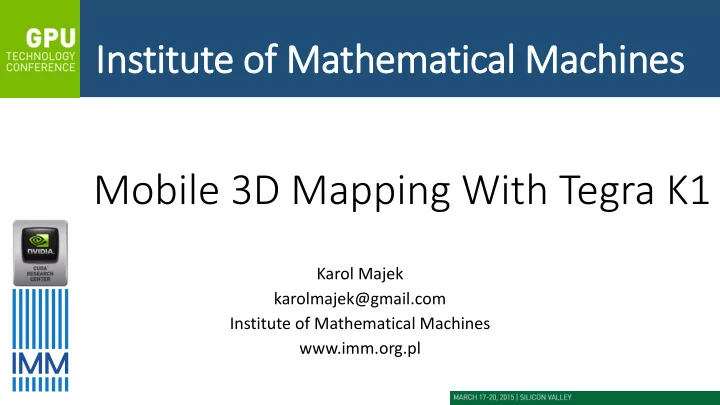

Institute of In f Mathematical Machines Mobile 3D Mapping With Tegra K1 Karol Majek karolmajek@gmail.com Institute of Mathematical Machines www.imm.org.pl
Mob obil ile 3D map appin ing • Mobile robotic platform • Rotating laser scanner • 3D data in stop-scan fashion • Processing using CUDA on robot
CUDA in in 3D map apping Janusz Będkowski – GTC 2012 Now with Jetson TK1 • The observations from robot are in the GPU memory immediately! • More data from the new sensors
CUDA in in 3D map apping • Regular Grid Decomposition • Cube (-1, -1, -1) to (1, 1, 1) • Partitioned into 2 n x 2 n x 2 n cubes (n=4, 5, …, 9) • Scale the pointcloud Będkowski Janusz, Andrzej Masłowski, Geert De Cubber. "Real time 3D localization and mapping for USAR robotic application." Industrial Robot: An International Journal 39.5 (2012): 464-474.
CUDA in in 3D map apping CPU CPU OpenMP CUDA Będkowski Janusz, Karol Majek, and Andreas Nüchter . "General purpose computing on graphics processing units for robotic applications." Journal of Software Engineering for Robotics 4.1 (2013): 23-33.
3D 3D map apping wit ith Je Jetson TK1 The hardware Laptop GTX 970m Jetson TK1 CUDA cores 1280 192 Base clock (MHz) 924 + boost 852 Number of 10 1 multiprocessors Architecture (Compute Maxwell (5.2) Kepler (3.2) Capability) Total global memory (MB) 3072 1746 Memory bus 192-bit 64-bit CPU Intel Core i7-4710HQ 4-Plus-1 quad-core ARM 2.5GHz Cortex A15 CPU
3D 3D map apping wit ith Je Jetson TK1 ICP iteration time Approximately 50 000 points 692 1000 64 x 64 x 64 grid 100 Time in ms 13 10 1 GeForce GTX 970M Jetson TK1
3D 3D map apping ICP 3D Data reduction Data Normal vector Classification Semantic ICP estimation
3D Data 53 scans Odometry and IMU DrRobot Jaguar 4x4 platform Mandala 3D rotating laser unit* *mandalarobotics.com The 3D datasets: lider.zms.imm.org.pl/
Data reductio ion 33 530 points 506 064 points 10cm voxel grid
Data reductio ion Data redutcion 16,6 16,5 15,1 14,5 10,1 10 Time in seconds 1,2 1,1 1,1 1,0 0,9 1 0,1 0,01 0,1 0,5 1 10 Grid size GTX 970M Jetson TK1 Input: 2 000 000 points
ICP ICP True NNS Approximate NNS
ICP ICP After 20 ICP iterations
Nor ormal vect ctor esti timation Steps: 1. NNS 2. Covariance matrix from NN 3. Principal Component Analysis (PCA) using Singular Value Decomposition(SVD) 4. Orientation towards the viewpoint
Cla lassific icatio ion Semantics by point labeling: • Wall (green) – plane • Floor (blue) – plane under robot • Ceiling (black) – plane above robot • Other (red)
Cla lassific icatio ion
Se Semantic IC ICP ICP Semantic ICP
Con onclusio ions Problems: • TK1 memory is limited to approx 1.7 GB • Low performance compared to modern laptop • Aproximate NNS decreases the final accuracy Solutions: • Small datasets – data reduction • Use of aproximate NNS instead of true NNS • More iterations of ICP or use of the semantic ICP
Ack cknowledgement This work is done with the support of NCBiR (Polish National Center for Research and Development) project: ” Research of Mobile Spatial Assistance System” Nr: LIDER/036/659/L-4/12/NCBR/2013
Than ank you ou for or you our attentio ion! Contact information: • e-mail: karolmajek@gmail.com • LinkedIn: www.linkedin.com/in/karolmajek • ResearchGate: www.researchgate.net/profile/Karol_Majek Please complete the Presenter Evaluation sent to you by email or through the GTC Mobile App. Your feedback is important!
Recommend
More recommend